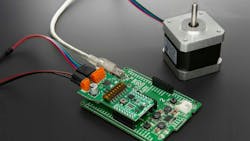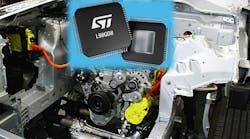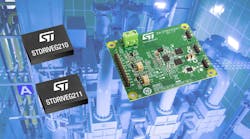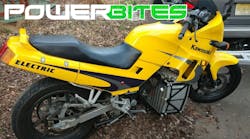Stepper-Motor Board Delivers Up to 2.7 A with BiCD Two-Phase Driver
MIKROE’s Stepper 28 Click is a compact add-on development board that enables precise control of two-phase bipolar stepper motors with supply voltages from 8.2 to 44 V. Capable of delivering up to 2.7-A output current, it comes with a full suite of firmware and development tools.
The board can be used to speed the development of motorized systems used in printers, scanners, and other office machinery, as well as cash drawers or point-of-sale receipt printers. It can also help accelerate the creation of stepper-driven dispensing mechanisms in vending machines or implement precise pan and tilt control in surveillance cameras.
The board is based on the TB67S559FTG, a BiCD (bipolar, CMOS, DMOS) constant-current two-phase, stepping-motor-driver IC from Toshiba Semiconductor and a set of low-RDS(on) DMOSFET output transistors.
The controller chip incorporates technologies such as Advanced Current Detect System (ACDS) for resistor-less current sensing and Advanced Dynamic Mixed Decay (ADMD) for optimized current regulation. This allows the controller board to support full-step to 1/32-step resolution for less motor noise and smoother control in addition to several anomaly detection indicators.
Stepper 28 Click is fully compatible with the mikroBUS socket, MIKROE’s prototyping add-on board standard. It comes with the mikroSDK open-source libraries to simplify evaluation and customization.
This Week in PowerBites
More PowerBites
About the Author
Lee Goldberg
Contributing Editor
Lee Goldberg is a self-identified “Recovering Engineer,” Maker/Hacker, Green-Tech Maven, Aviator, Gadfly, and Geek Dad. He spent the first 18 years of his career helping design microprocessors, embedded systems, renewable energy applications, and the occasional interplanetary spacecraft. After trading his ‘scope and soldering iron for a keyboard and a second career as a tech journalist, he’s spent the next two decades at several print and online engineering publications.
Lee’s current focus is power electronics, especially the technologies involved with energy efficiency, energy management, and renewable energy. This dovetails with his coverage of sustainable technologies and various environmental and social issues within the engineering community that he began in 1996. Lee also covers 3D printers, open-source hardware, and other Maker/Hacker technologies.
Lee holds a BSEE in Electrical Engineering from Thomas Edison College, and participated in a colloquium on technology, society, and the environment at Goddard College’s Institute for Social Ecology. His book, “Green Electronics/Green Bottom Line - A Commonsense Guide To Environmentally Responsible Engineering and Management,” was published by Newnes Press.
Lee, his wife Catherine, and his daughter Anwyn currently reside in the outskirts of Princeton N.J., where they masquerade as a typical suburban family.
Lee also writes the regular PowerBites series.





